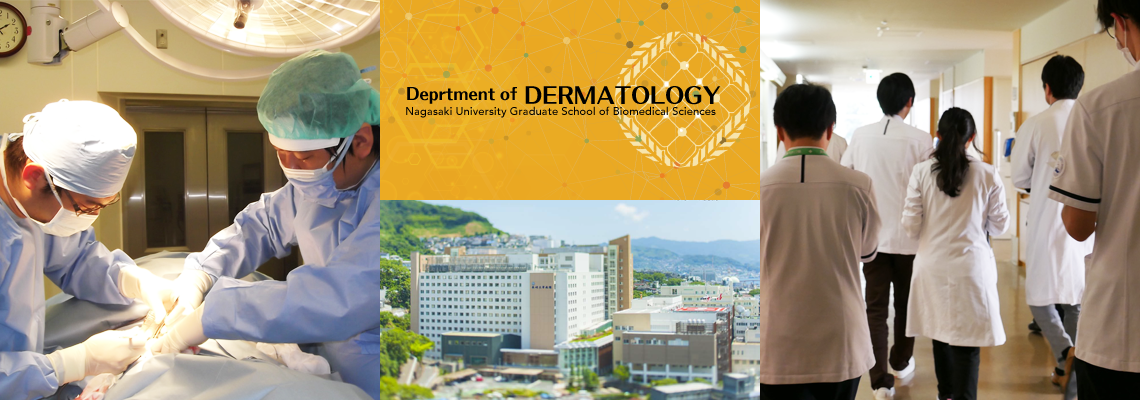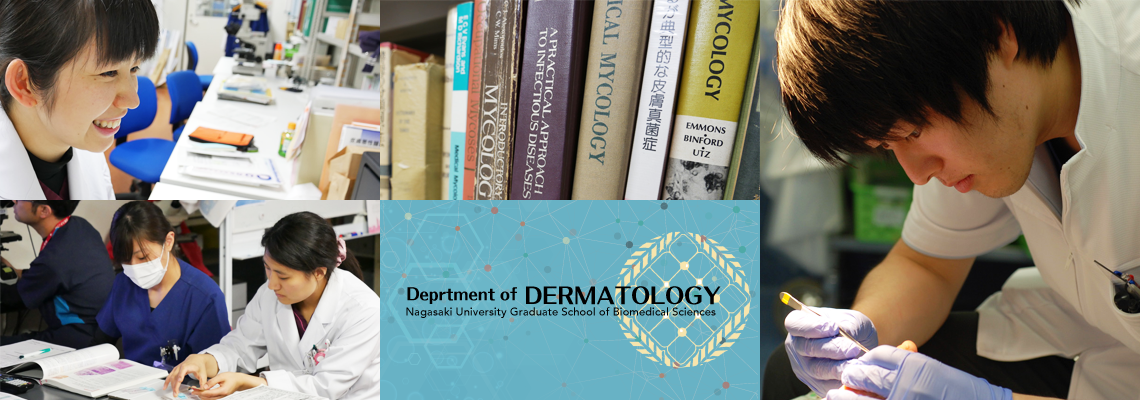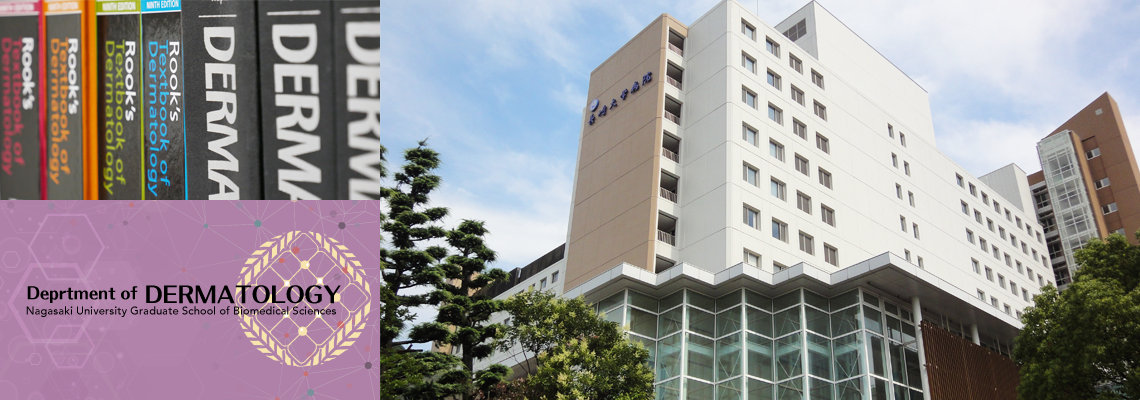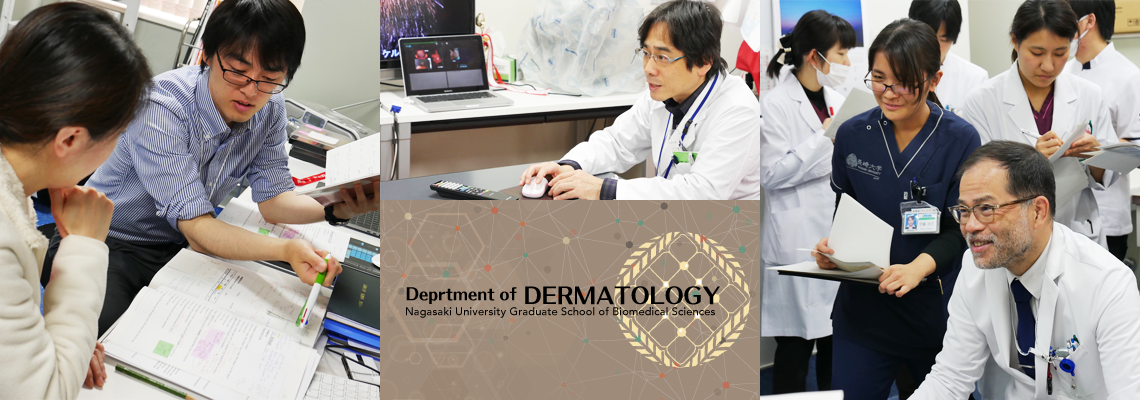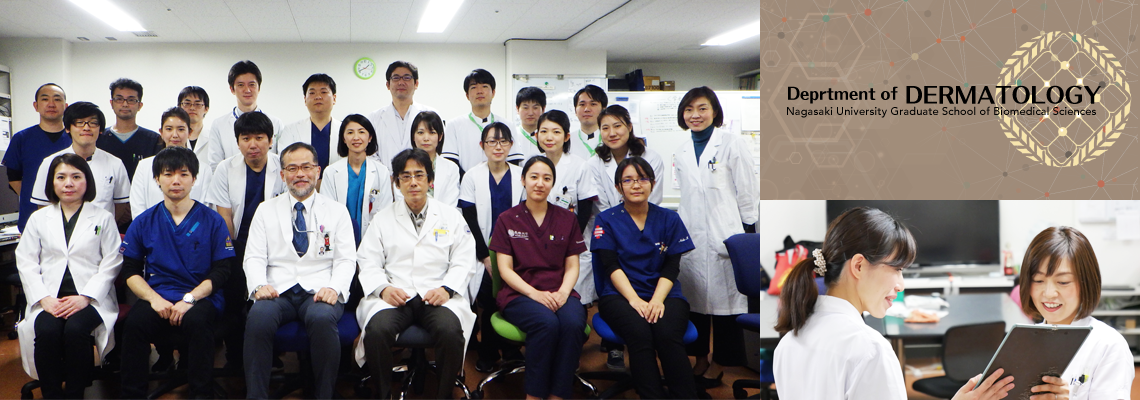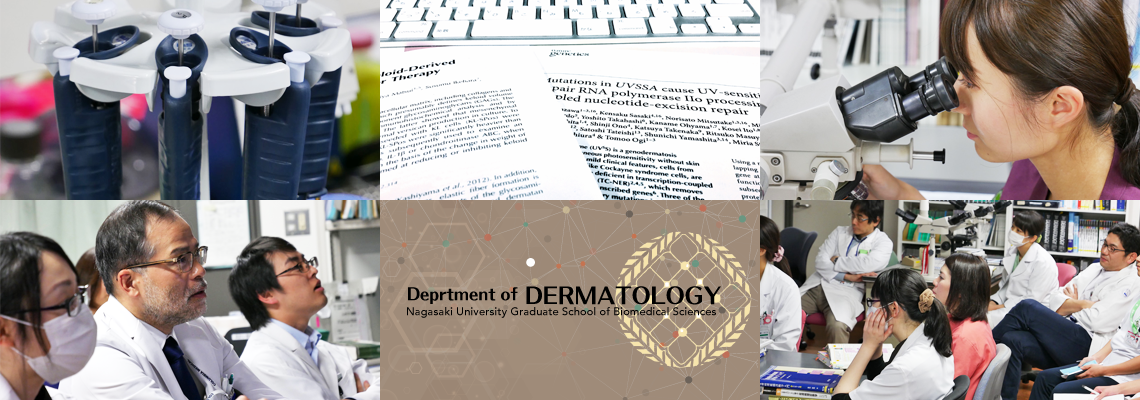History
Medical school of Nagasaki (Igaku Denshusho), the origin of Nagasaki University school of medicine, established by the Dutch army doctor Pompe van Meerdervoort in 1857, is the oldest Western medical school in Japan.
https://www.nagasaki-u.ac.jp/en/prospective/pdf/historicalR3.pdf
The Dermatology Department was founded in 1914. The 100th anniversary of the opening of Department of Dermatology, Nagasaki University Graduate School of Medicine and Dental Medicine was celebrated in 2014.
https://www.nagasaki-u.ac.jp/en/prospective/pdf/historicalR3.pdf
The Dermatology Department was founded in 1914. The 100th anniversary of the opening of Department of Dermatology, Nagasaki University Graduate School of Medicine and Dental Medicine was celebrated in 2014.
Clinic
The Nagasaki University Hospital Dermatology and Allergology Department conducts an average of 100 outpatient visits and approximately 20 inpatient visits daily. Our clinic treats every skin disorder, including characteristic allergic diseases, tumors (e.g., malignant/benign skin tumors and cutaneous lymphomas), inflammatory skin disorders (e.g., psoriasis), infectious skin diseases (e.g., fungal and bacterial infections), collagen diseases, and sweating disorders (e.g., hypohidrosis and hyperhidrosis). For tumor treatment, we provide comprehensive therapy involving dermato-surgery, immune check point inhibitors, chemotherapy, and radiation therapy. We have a core clinic for pseudoxanthoma elasticum (PXE) that offers general examination, genetic diagnosis, and treatment. To provide our patients with the best medical care, all medical staff continuously perform clinical practices and clinical research.
Research
Our comprehensive research theme is to develop improved treatment options for intractable diseases from the perspective of dermatologists. To date, we have created unique experimental methodologies by exploiting the unique features of skin, including its ease of access. Thus, we can evaluate physiological functions of skin by obtaining images of skin in vivo. Our efforts have mainly focused on studies of human.
Diseases that are being studied in our laboratory include:
- Skin allergies (e.g. atopic dermatitis, contact dermatitis, prurigo, and urticaria)
- Mechanism of itch (e.g. touch alloknesis, heat provoked itch, pruritus cutaneous)
- Infectious diseases (e.g. fungal and bacterial infection, mycobiome)
- Occupational skin diseases (e.g., hand eczema, skin allergies, tumors)
- Sweating disorders (e.g., hypohidrosis, hyperhidrosis, and allergic skin diseases)
- Inflammatory skin disorders (e.g., psoriasis, psoriasis arthropathica, palmoplantar pustulosis)
- Collagen diseases (e.g., scleroderma, morphea, systemic lupus erythematosus, and Sjogren syndrome)
- Malignant tumors (e.g., melanoma, basal cell carcinoma, squamous cell carcinoma, Paget’s disease, and lymphomas)
- Benign tumors (e.g., keloid, seborrheic keratosis, and neurofibroma)
- Genetic diseases (e.g., pseudoxanthoma elasticum).
Our laboratories possess the necessary equipment in sufficient condition to perform cell culture, measurement of nucleotide and protein expression, and histological analyses (including immunofluorescence). Furthermore, members of our department have access to institutional shared equipment (e.g., confocal microscope, two-photon microscope, laser microdissection, and mass spectrometer), which allow for additional innovative experiments [e.g., 3D imaging of peripheral nerve and blood vessels in skin, dynamic analysis of skin appendix (especially for sweat glands), biology of immune cells, RNA-seq-based transcriptome analysis, and gene sequencing]. We routinely perform genetic diagnosis of genetic diseases (e.g. pseudoxanthoma elasticum) and utilize an innovative approach for objective assessment of disease severity and treatment.
Our recent achievements can be found at the link below:

Our recent achievements can be found at the link below:

A message from Chairman Hiroyuki Murota on behalf of the faculty
Thank you for visiting our web site.
In May 2018, I was appointed as the 14th professor in the Department of Dermatology, Nagasaki University Graduate School of Medicine and Dental Medicine, and Dermatology and Allergology Department at Nagasaki University Hospital. Previously, I practiced clinical medicine and progressive dermatology research with my colleagues at Nagasaki University and Osaka University. During this time, I accumulated valuable experience and achievements in the fields of skin allergies, collagen diseases, sweat biology, itch/pruritus, and hereditary diseases. It is my great pleasure to contribute to the development of Japanese clinical guidelines for atopic dermatitis, pruritus cutaneous, prurigo, and hand eczema.
The Nagasaki University Hospital Dermatology and Allergy Department offers distinct medical care tailored to the needs of our community and hospital. Furthermore, it is one of the leading medical treatment centers in the country involved in the diagnosis and treatment of rare diseases, intractable diseases, and skin infections. The interests and future directions of our department follow worldwide developments in medicine as new medical issues arise over time. We have a history of accurately capturing the needs of the times and contributing to society by addressing those issues.
In May 2018, I was appointed as the 14th professor in the Department of Dermatology, Nagasaki University Graduate School of Medicine and Dental Medicine, and Dermatology and Allergology Department at Nagasaki University Hospital. Previously, I practiced clinical medicine and progressive dermatology research with my colleagues at Nagasaki University and Osaka University. During this time, I accumulated valuable experience and achievements in the fields of skin allergies, collagen diseases, sweat biology, itch/pruritus, and hereditary diseases. It is my great pleasure to contribute to the development of Japanese clinical guidelines for atopic dermatitis, pruritus cutaneous, prurigo, and hand eczema.
The Nagasaki University Hospital Dermatology and Allergy Department offers distinct medical care tailored to the needs of our community and hospital. Furthermore, it is one of the leading medical treatment centers in the country involved in the diagnosis and treatment of rare diseases, intractable diseases, and skin infections. The interests and future directions of our department follow worldwide developments in medicine as new medical issues arise over time. We have a history of accurately capturing the needs of the times and contributing to society by addressing those issues.
To Patients
We provide appropriate, front-line therapies for intractable skin diseases [e.g., allergies, inflammation, infectious diseases, skin tumors, collagen diseases, sweat disorders (e.g., hyperhidrosis and hypohidrosis), and hereditary diseases] by dermatologists who are experts for each disease. To consult our clinic, please visit the web site for Nagasaki University:
http://www.mh.nagasaki-u.ac.jp/imc/en/access/
http://www.mh.nagasaki-u.ac.jp/imc/en/access/
To Medical Students
Skin is a unique organ as it can be inspected and palpated directly with our eyes and hands. Information derived from physical dermatological examination of skin, nail, and hair tissues can provide clues for inferring systemic health conditions. Dermatological examination is an extremely useful skill in situations where there is no medical testing equipment available for diagnosis.
Dermatology is an attractive medical field that combines medical and surgical aspects. I expect all medical students trained at Nagasaki University to understand the diagnostic skills necessary to glean as much information as possible from the skin.
Dermatology is an attractive medical field that combines medical and surgical aspects. I expect all medical students trained at Nagasaki University to understand the diagnostic skills necessary to glean as much information as possible from the skin.
To Young Doctors
The goal of our program is to train dermatologists in the skills necessary to provide patients with appropriate medical care through the identification of symptoms and deciphering of signs. Additionally, clinicians will be taught to consider the cause of the dermatoses based on histopathological findings, the patient's general condition, background factors, and patient lifestyle. The latest technology in pathologic diagnosis, bacterial species identification in skin infections, image examination, and skin sensation and physiological function (e.g. perspiration) evaluation will be taught. When we provide medical treatment, we should be acquainted with the skill of basic dermatological therapies, and then acquire proficient knowledge of the use of molecular target treatments and accumulate experience with innovative treatment strategies. To develop well-rounded dermatologists, our dermatologists acquire skills in practical skin surgery techniques, treatment of skin tumors, and plan development for surgery and follow-up of cases.
Contact Us
Department of Dermatology,
Graduate School of Biomedical Sciences, Nagasaki University
(Nagasaki University Hospital)
1-7-1 Sakamoto, Nagasaki 852-8523, Japan
Graduate School of Biomedical Sciences, Nagasaki University
(Nagasaki University Hospital)
1-7-1 Sakamoto, Nagasaki 852-8523, Japan
| Medical Office | University Hospital Main Building: The 10th Floor |
|---|

